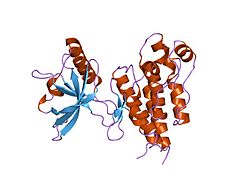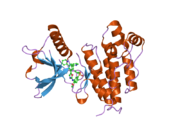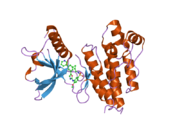Receptor kinaznog umetnutog domena
Prijeđi na navigaciju
Prijeđi na pretragu
| edit |
Receptor kinaznog umetnutog domena (KDR, tip III receptorske tirozinske kinaze, receptor 2 vakkularnog endotelnog faktora rasta, VEGFR-2, Flk1, fetalna jetrena kinaza 1) je VEGF receptor. KDR je ljudski gen koji kodira ovaj enzim. KDR se takođe označava sa CD309 (klaster diferencijacije 309).
Interakcije[uredi | uredi kod]
Receptor kinaznog umetnutog domena formira interakcije sa SHC2,[1] Aneksin A5[2] i SHC1.[3][4]
Vidi još[uredi | uredi kod]
Reference[uredi | uredi kod]
- ↑ Warner, A J; Lopez-Dee J; Knight E L; Feramisco J R; Prigent S A (April 2000). „The Shc-related adaptor protein, Sck, forms a complex with the vascular-endothelial-growth-factor receptor KDR in transfected cells”. Biochem. J. (England) 347 (Pt 2): 501–9. DOI:10.1042/0264-6021:3470501. ISSN 0264-6021. PMC 1220983. PMID 10749680.
- ↑ Wen, Y; Edelman J L; Kang T; Sachs G (May 1999). „Lipocortin V may function as a signaling protein for vascular endothelial growth factor receptor-2/Flk-1”. Biochem. Biophys. Res. Commun. (UNITED STATES) 258 (3): 713–21. DOI:10.1006/bbrc.1999.0678. ISSN 0006-291X. PMID 10329451.
- ↑ Zanetti, Adriana; Lampugnani Maria Grazia; Balconi Giovanna; Breviario Ferruccio; Corada Monica; Lanfrancone Luisa; Dejana Elisabetta (April 2002). „Vascular endothelial growth factor induces SHC association with vascular endothelial cadherin: a potential feedback mechanism to control vascular endothelial growth factor receptor-2 signaling”. Arterioscler. Thromb. Vasc. Biol. (United States) 22 (4): 617–22. DOI:10.1161/01.ATV.0000012268.84961.AD. PMID 11950700.
- ↑ D'Angelo, G; Martini J F; Iiri T; Fantl W J; Martial J; Weiner R I (May 1999). „16K human prolactin inhibits vascular endothelial growth factor-induced activation of Ras in capillary endothelial cells”. Mol. Endocrinol. (UNITED STATES) 13 (5): 692–704. DOI:10.1210/me.13.5.692. ISSN 0888-8809. PMID 10319320.
Literatura[uredi | uredi kod]
- Holmes K, Roberts OL, Thomas AM, Cross MJ. (October 2007). „Vascular endothelial growth factor receptor-2: structure, function, intracellular signalling and therapeutic inhibition.”. Cell Signal. 19 (10): 2003–2012. DOI:10.1016/j.cellsig.2007.05.013. PMID 17658244.
- Petrova TV, Makinen T, Alitalo K (1999). „Signaling via vascular endothelial growth factor receptors.”. Exp. Cell Res. 253 (1): 117–30. DOI:10.1006/excr.1999.4707. PMID 10579917.
- Sato Y, Kanno S, Oda N, et al. (2000). „Properties of two VEGF receptors, Flt-1 and KDR, in signal transduction.”. Ann. N. Y. Acad. Sci. 902 (1): 201–5; discussion 205–7. DOI:10.1111/j.1749-6632.2000.tb06314.x. PMID 10865839.
- Zachary I, Gliki G (2001). „Signaling transduction mechanisms mediating biological actions of the vascular endothelial growth factor family.”. Cardiovasc. Res. 49 (3): 568–81. DOI:10.1016/S0008-6363(00)00268-6. PMID 11166270.
- Vené R, Benelli R, Noonan DM, Albini A (2001). „HIV-Tat dependent chemotaxis and invasion, key aspects of tat mediated pathogenesis.”. Clin. Exp. Metastasis 18 (7): 533–8. DOI:10.1023/A:1011991906685. PMID 11688957.
- Lenton K (2003). „VEGFR-2 (KDR/Flk-1).”. J. Biol. Regul. Homeost. Agents 16 (3): 227–32. PMID 12456025.
- Matsumoto T, Mugishima H (2006). „Signal transduction via vascular endothelial growth factor (VEGF) receptors and their roles in atherogenesis.”. J. Atheroscler. Thromb. 13 (3): 130–5. DOI:10.5551/jat.13.130. PMID 16835467.



